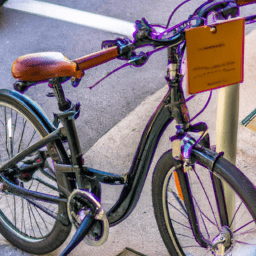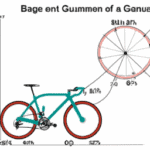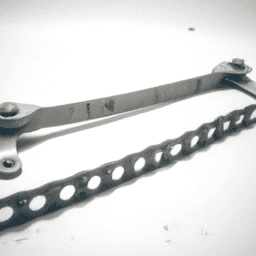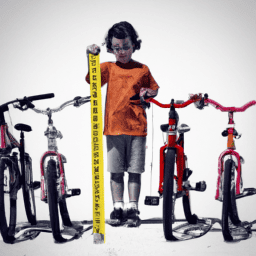As someone who is passionate about cycling, the idea of bike stability has always caught my attention. Despite seeming straightforward, the challenge of understanding why a bicycle tips over has baffled researchers, engineers, and cycling aficionados for hundreds of years.
In this article, I will delve into the physics of bicycle stability, the science of bicycle motion, and the history of bicycle design in order to better understand the factors that affect bicycle stability and offer tips for improving it.
The concept of bicycle stability can be quite complex, as it involves a wide range of factors that impact the balance and control of the bicycle. From the weight distribution of the rider to the angle of the handlebars, there are many variables that can affect the stability of a bicycle.
As someone who has experienced the frustration of losing balance while riding, I am eager to explore the science behind bicycle stability and learn more about how I can improve my own riding technique. So, let’s dive into the fascinating world of bicycle stability and discover why the bicycle falls over.
Key Takeaways
- Weight distribution and handlebar angle affect bicycle stability.
- Center of gravity is crucial for maintaining balance.
- Rider input, including steering and balance adjustments, is necessary for stability.
- Technological advancements have been incorporated into bicycle designs.
The Physics of Bicycle Stability
The bicycle’s stability is determined by a complex interaction between various physical factors, such as the distribution of weight, the center of gravity, and the speed and direction of movement. The center of gravity plays a vital role in maintaining the bicycle’s balance. It’s the point where the weight of the bicycle and the rider is concentrated.
When the center of gravity is positioned over the wheels, the bicycle remains upright. However, if the center of gravity shifts outside the wheelbase, the bicycle becomes unstable, and the rider loses balance, causing the bicycle to fall over.
Another essential factor in bicycle stability is the gyroscopic effect. The wheels of the bicycle act as gyroscopes, generating a force that resists any change in the direction of motion. This effect is why a bicycle remains upright even when the rider isn’t pedaling.
However, the gyroscopic effect alone isn’t enough to keep the bicycle stable. The rider’s input, including steering and balance adjustments, is necessary to maintain the bicycle’s stability. Understanding the physics behind bicycle stability is crucial to understanding the science of bicycle motion, which we’ll explore in the next section.
The Science of Bicycle Motion
You’ll love learning about how bikes move and work! It’s fascinating to explore the bicycle dynamics that allow these machines to move and stay upright.
The science of bicycle motion is a complex field that involves the study of balance control, forces, and energy transfer. Here are three things you may not have known about bicycle dynamics:
-
Countersteering is a technique that allows you to turn your bike by steering in the opposite direction you want to go. This may seem counterintuitive, but it works because it creates a lean in the opposite direction, which then allows you to turn.
-
When you pedal a bike, you’re actually converting chemical energy from your body into kinetic energy that propels the bike forward. This process involves a complex interplay of forces, including friction, air resistance, and gravity.
-
Balance control is key to staying upright on a bike. Without it, you’d fall over as soon as you started moving. The two main factors that affect balance control are the distribution of weight on the bike and the speed at which you’re moving.
Understanding bicycle dynamics is crucial for anyone who wants to ride a bike safely and efficiently.
Now, let’s dive into the history of bicycle design and see how these machines have evolved over time.
The History of Bicycle Design
Get ready to take a trip through time as we explore how people like you have been innovating and improving bicycle designs for over a century. The history of bicycle design is a fascinating story of evolutionary changes and technological advancements.
From the earliest models made of wood and metal, to the modern carbon fiber frames of today, the bicycle has undergone a remarkable transformation. In the 19th century, bicycles began to gain popularity as a form of transportation. This led to the development of new designs which were more efficient and comfortable for riders.
Over time, technological advancements such as gears, brakes, and lighter materials were incorporated into bicycle designs. These changes have not only made bicycles more comfortable and efficient, but also safer and faster. The evolution of bicycle design continues to this day, with new materials, designs, and technologies being developed to improve the performance and functionality of the bicycle.
As we move forward, it’s important to continue exploring and innovating in bicycle design to ensure that this incredible machine continues to serve us well for years to come. With all these advancements, however, factors such as weight distribution and tire pressure can still affect bicycle stability.
Let’s explore these factors in more detail in the next section.
Factors that Affect Bicycle Stability
As a cyclist, I’ve experienced firsthand how wind and weather conditions can affect the stability of a bicycle.
The direction and strength of the wind can make it difficult to maintain a straight line, while rain or wet roads can decrease traction and increase the risk of slipping.
Additionally, the road surface and terrain can also impact stability. Uneven surfaces and steep inclines require more attention and control from the rider.
Understanding these factors is crucial for maintaining safe and stable cycling.
Wind and Weather Conditions
With the gust of wind, the bike toppled like a house of cards. Wind is a significant factor in bicycle stability, and it can be particularly dangerous when it comes in sudden gusts. The effect of gusts can be unpredictable and can cause a bike to tip over, especially if the rider is not prepared. The importance of wind direction cannot be overstated, as a crosswind can push a bike off course, while a headwind can slow the rider down and make it more difficult to maintain balance.
To better understand the impact of wind on bicycle stability, let’s take a look at the following table:
| Wind Speed | Wind Direction | Effect on Bicycle |
|---|---|---|
| 0-5mph | Headwind | Negligible |
| 0-5mph | Crosswind | Minor turbulence |
| 5-10mph | Headwind | Slight resistance |
| 5-10mph | Crosswind | Moderate turbulence |
| 10-20mph | Headwind | Significant resistance & instability |
| 10-20mph | Crosswind | Strong turbulence & instability |
| 20+ mph | Any | Extreme turbulence & danger |
As the wind speed and direction increase, so does the risk of instability and potential danger to the rider. It is crucial to be aware of weather conditions before heading out for a ride and to adjust riding techniques accordingly. The next factor in bicycle stability is the road surface and terrain.
Road Surface and Terrain
Navigating different road surfaces and terrains can be a challenge for me as a cyclist, affecting my bike’s stability and ability to maintain traction. When cycling on gravel roads, for example, I have to be mindful of the loose stones and uneven surface that can cause my bike to wobble and lose balance.
It’s important to keep a steady pace and avoid sudden movements that can cause my wheels to slip. Similarly, uneven pavement can also be a factor that affects my bike’s stability. Potholes, cracks, and bumps on the road can cause my bike to jerk and sway, making it difficult to maintain a straight line.
In situations like these, it’s important to keep a firm grip on the handlebars and adjust my speed accordingly. By being aware of the potential hazards of different road surfaces and terrains, I can better anticipate and respond to changes in my environment, improving my overall safety and stability while cycling.
As a result, it’s important to take steps to improve bicycle stability, such as adjusting tire pressure for specific road conditions, choosing the right bike for the terrain, and maintaining proper body posture. By doing so, I can ensure that my bike remains stable and easy to handle regardless of the surface or terrain I encounter.
Tips for Improving Bicycle Stability
Improving your bicycle’s stability can make your ride smoother and more enjoyable. Proper posture and counterbalancing are two key factors that can help improve stability.
When riding a bike, it’s important to keep your body centered over the frame and maintain a neutral spine. This means keeping your shoulders relaxed and your elbows slightly bent. By doing this, you’ll be able to shift your weight more easily and maintain control over your bike.
Choosing the right bike size is also crucial for stability. A bike that’s too big or too small can make it difficult to control and balance. When choosing a bike, make sure to consider your height, weight, and riding style. Take the time to test ride different bikes and find the one that feels most comfortable and stable for you.
Additionally, adding accessories like fenders or a rear rack can help distribute weight more evenly and improve stability.
By following these tips, you can enjoy a smoother, more stable ride on your bicycle.
Frequently Asked Questions
How do I fix a flat tire on my bicycle?
My bicycle tire is flat, but I’m confident I can fix it with some Bicycle pump maintenance. First, I’ll check the Bicycle tire pressure and then use the pump to inflate it. Time to hit the road again!
What is the best type of bicycle for a beginner?
As a beginner, I recommend a road bike for its simplicity and comfort. Mountain bikes can be more challenging to handle. Electric bikes offer assistance, but may hinder skill development. Consider the pros and cons before choosing.
How often should I have my bicycle serviced?
I recommend having your bicycle serviced at least once a year to ensure optimal performance and safety. Regular maintenance, such as cleaning and lubricating, can be done as DIY repairs to extend the life of your bike.
What is the proper way to adjust my bicycle seat?
To properly adjust your bicycle seat, start by ensuring it’s at the right height for your leg length. Next, adjust the tilt and fore/aft position for comfort and efficiency. Avoid common mistakes like tilting the seat too far forward or back. Troubleshoot discomfort with small adjustments.
How do I properly lock my bicycle to prevent theft?
I’ve researched bicycle lock types and found that U-locks are the most secure. Tips for preventing bicycle theft include locking it to a fixed object and using multiple locks. Always register your bike and record its serial number.
Conclusion
In conclusion, the mystery of why the bicycle falls over can be explained through the principles of physics and the science of motion.
Factors such as weight distribution, center of gravity, and wheelbase all play a role in the stability of a bicycle.
Through the evolution of bicycle design, manufacturers have continually improved upon these factors to create more stable and efficient bicycles.
However, even the most advanced bicycles can still fall over if not properly maintained or operated.
Riders can improve their stability by practicing proper technique, adjusting their body position, and maintaining their equipment.
So next time you hop on your bicycle, remember the delicate balance between stability and motion, and enjoy the freedom of the ride.
















